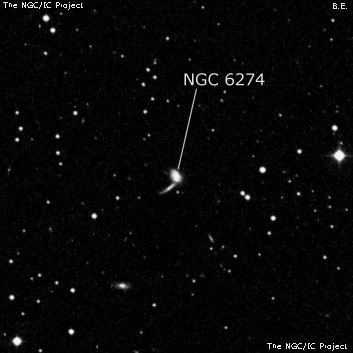NGC/IC Project Restoration Effort
(This is a very very beta version)
NGC6274


Basic Information
Location and Magnitude
Right Ascension: 16:59:20.4
Declination: +29:56:47
Constellation: HER
Visual Magnitude: 13.8
Historic Information
Discoverer: Marth
Year of discovery: 1864
Discovery aperture: 48.0
Observational
Summary description: eF, vS
Sub-type: Sc
Corwin's Notes
=====
NGC 6274. Steve Gottlieb has pointed out that there is an appropriate galaxy,
UGC 10654, just one minute of time east of Marth's position. This contrasts
strongly with the object I chose earlier, the double galaxy UGC 10643, which
is 15 seconds of time west and 11 arcminutes north of Marth's place. It looks
like Reinmuth was the first to suggest the latter object, but aside from RNGC,
the major 20th century catalogues (CGCG, MCG, and UGC) simply ignored the NGC
number.
Steve's suggestion is pretty convincing, so I've changed the identification of
the NGC object. It is marked with a colon in the position table, while the
double galaxy is now flagged with question marks.
Steve's Notes
=====
NGC 6274
24" (7/15/15): faint to fairly faint, small, slightly elongated N-S, 18"x12", small slightly brighter nucleus. A mag 15 star is just off the southwest side [20" from center]. Forms a pair with NGC 6282 6.2' NNE.
UGC 10643, which is identified as NGC 6274 in the RNGC, PGC, NED and SIMBAD is located 21' NW. At 225x and 375x it appeared faint to fairly faint, small, roundish, ~22"x18", small slightly brighter nucleus. UGC 10643b = MCG +05-40-020 is a very challenging galaxy (B = 16.5) attached on the south end. At 225x; UGC 10643b was occasionally visible as an extremely faint glow (too brief/faint for shape). At 375x I could tell it was elongated to the southeast when it popped.
17.5" (7/1/89): faint, very small, slightly elongated N-S, weak concentration. A mag 15 star is off the southwest edge 19" from the center. Located 6' SSW of NGC 6282.
UGC 10643, which is identified as NGC 6274 in the RNGC and PGC, is located 21' NW. It appeared faint, small, possibly elongated E-W, brighter core. Located 2' E of an isosceles triangle consisting of three mag 13-14 stars. The nearest of these stars is a close double.



